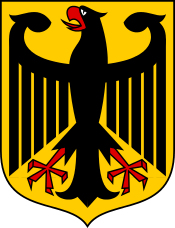German federal election, 1890
| | |||||||||||||||||||||||||||||||||||||||||||||||||||||||||||||||||||||||||||||||||||||||||||
| |||||||||||||||||||||||||||||||||||||||||||||||||||||||||||||||||||||||||||||||||||||||||||
| |||||||||||||||||||||||||||||||||||||||||||||||||||||||||||||||||||||||||||||||||||||||||||
 |
| This article is part of a series on the politics and government of Germany |
|
Constitution ("Fundamental Law Code") |
|
| Foreign relations |
Federal elections were held in Germany on 20 February 1890.[1] The Centre Party regained its position as the largest party in the Reichstag by winning 106 of the 397 seats, whilst the National Liberal Party, formerly the largest party, was reduced to 42 seats. Despite receiving the most votes, the Social Democratic Party won only 35 seats.[2] Voter turnout was 71.5%.[1]
Results
| Party | Votes[a] | % | Seats | +/– |
|---|---|---|---|---|
| Social Democratic Party | 1,427,300 | 19.7 | 35 | +24 |
| Centre Party | 1,342,100 | 18.6 | 106 | +8 |
| National Liberal Party | 1,177,800 | 16.3 | 42 | −57 |
| German Free-minded Party | 1,159,900 | 16.0 | 66 | +34 |
| German Conservative Party | 895,100 | 12.4 | 73 | −7 |
| German Reich Party | 482,300 | 6.7 | 20 | −21 |
| Polish Party | 246,800 | 3.4 | 16 | +3 |
| German People's Party | 147,600 | 2.0 | 10 | +10 |
| German-Hanoverian Party | 112,700 | 1.6 | 11 | +7 |
| Alsace-Lorraine Party | 101,100 | 1.4 | 10 | −5 |
| Anti-Semites[b] | 47,500 | 0.7 | 5 | +4 |
| Danish Party | 14,000 | 0.2 | 1 | 0 |
| Others | 74,600 | 1.0 | 2 | 0 |
| Invalid/blank votes | 33,100 | – | – | – |
| Total | 7,261,600 | 100 | 397 | 0 |
| Registered voters/turnout | 10,145,900 | 71.5 | – | – |
| Source: Nohlen & Stöver, DGDB | ||||
a Figures for votes are rounded.[1]
b Of the five seats won by the Anti-Semites, four were held by Otto Böckel's Anti-Semitic People's Party and one by Max Liebermann von Sonnenberg's German Social Anti-Semitic Party.[3]
References
This article is issued from Wikipedia - version of the 3/12/2014. The text is available under the Creative Commons Attribution/Share Alike but additional terms may apply for the media files.